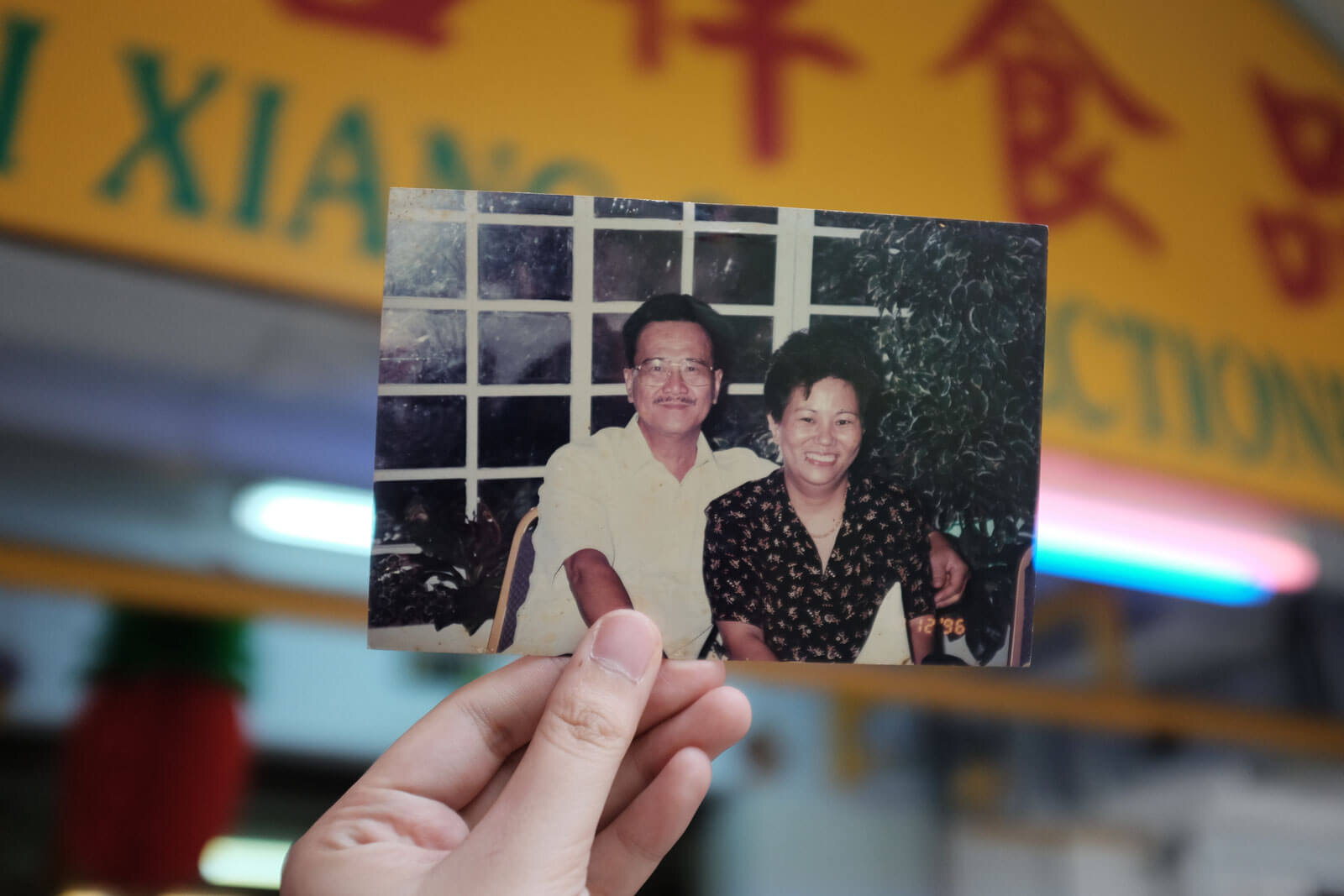Love, luck and prosperity
Issue #1
By Sheryl Lee
Nestled in Everton Park, an upscale neighbourhood with an imposing 50-storey residential icon, is an old- school ang ku kueh shop that has been in business for three decades. It sprawls across two shops’ worth of space and so has two signboards – in a warm yellow hue, they sport dark red Chinese characters that say ‘Ji Xiang Confectionery (Ang Ku Kueh)’.
Neon blue and pink lights brighten the shopfront. In any other place they might have looked tacky, but here they cast a warm and inviting glow. A small TV screen mounted in a corner plays pictures of multi-coloured ang ku kueh. Each one is a shade softly glowing, more jewel than confectionery. It’s 11:30 am on a Saturday and in front of me is a queue of seven. I take my place behind an auntie and listen in on other people’s orders.
Two employees are taking orders behind double glass display cases. I peer into the cases but they are plastered with laminated newspaper clippings and certificates. Behind this counter, a darkened glass panel separates the shopfront from the kitchen, where stacks of steamers puff away merrily and release small white wisps of vapour. A mixer is at work in a corner.
A young woman chooses coconut, only to be told it is sold out. What about corn? None left, either. She settles for third choice, peanut. Then the auntie asks for 30 pieces of salted bean kueh and it’s my turn. I choose my favourite – sweet bean ang ku kueh.
I pick up the kueh, which feels soft and warm. Coated in a light sheen of oil, it was breathing in a steamer mere minutes ago.
Biting into the kueh, I find a soft and chewy parcel of smooth and comforting filling – not too sweet, skin perfectly melded to bean. I pull at it and it pulls back.
Is it any wonder ang ku kueh is the food of the gods?
Mr Toh Poh Seek, 69 and the boss of Ji Xiang, has a gravelly voice and the rough, callused hands of a former ship welder. He came from poverty – selling vegetables, cutting hair, and working at a kopitiam before eventually winding up at a Jurong shipyard, where he met the brother of his wife-to-be.
His wife, Mrs Toh Bong Yeo, is 65 and of Hokkien descent, with short brown curls that frame a round, beaming face. “We chatted, and realised we had chemistry,” she says of her brother’s ex-colleague. The Tohs took walks together, then progressed to dates at the old Wisma Theatre at Orchard Road. In the 1970s there were often live shows featuring stars from Taiwan or China.
Mr Toh’s parents had worked as part of a Chinese opera troupe after immigrating to Singapore from Fuzhou, China. “So you both had an interest in theatre,” I conclude.
“No, no,” Mr Toh interjects quickly. “It was just an excuse...”
. . .
Mrs Toh, who enjoyed eating kueh, took confectionery-making classes at a community centre in the 1980s. When friends and family sang praises about her ang ku kueh, she started selling some in her mother’s provision shop at Silat Kampung.
“At first we placed them in the shop for just a day or two. But afterwards people kept coming by to ask, ‘Why don’t you sell it anymore?’ And at the time my husband was out of job.”
It was the crippling recession of the 1980s, and the shipping industry’s fortunes had sunk.
So commenced the Tohs’ year of ang ku kueh-making. With their furniture given away and the three children safely ensconced in their rooms, kueh-making tables dominated the living room. Husband and wife settled down to produce ang ku kueh in earnest – and desperation.
“It was a terrible time. I had nothing to do, no subcontracts. We had to sell off our van, assets, everything,” says Mr Toh.
He channelled his former welder’s strength into kneading glutinous rice flour and oil into a shiny, pliable dough. Mrs Toh cooked the filling and their eldest son, who was then 11, helped cut banana leaves.
Thanks to a second brother who sold buns, Mr Toh had many friends in the food trade. In addition to the provision shop, the Tohs sold their ang ku kueh at friends’ stalls in coffeeshops. The kuehs were of such excellence they always sold out. But the home-based factory only lasted a year before they received news of a crackdown by the authorities in the late 1980s.
Mr Toh rented a space at Everton Park and set up shop. “I told my friends, I don’t want to do shipbuilding anymore, I want to make ang ku kueh! They called me crazy. They said I was good with hammers and heavy equipment, not making soft squishy kueh.”
Ji Xiang Confectionery (‘Ji’ means luck, and ‘Xiang’ means prosperity in Mandarin) opened its doors in 1988. It produced ang ku kueh of just three classic flavours – peanut, sweet bean and salted bean.
Mrs Toh found operations too ambitious to begin with, saying such things as “This cooking pot is so big, our children could swim in it”. She explains: “Mostly, I lacked confidence. I was thinking, who even eats ang ku kueh anymore? Only the older generation does.”
At the shipyard, Mr Toh had gathered a group of welders to do some subcontracting work. He now mustered these entrepreneurial energies into building a brand. He had a mahjong tile-carving friend mark their moulds with Ji Xiang (instead of the typical ‘Shou’ for longevity). “That way people can’t say our kueh is theirs when it isn’t. No one can copy it.”
It was also not enough to simply rely on traditional Chinese festivals to drive sales. “Ang ku kueh as something you eat only on special occasions wouldn’t make for a successful business. It has to be a snack – for the Malays, Muslims, Catholics, Christians and so on.”
Mr Toh set about redefining ang ku kueh. “We wanted our kueh to become a snack for young people. We thought of new flavours. If you have sweet bean, why not corn? Or coconut? I mean, tu tu kueh also uses coconut.”
Ji Xiang boasts six flavours of ang ku kueh – the three original ones and corn, coconut and yam. Occasionally there is a seventh, durian. But the line between ingenuity and excess is one the Tohs are careful not to cross.
Mrs Toh has tried a variety of her competitors’ flavours – coffee, green tea, mango and so on. “They’re strange,” she says, with a baffled look. “I don’t think they taste good... it’s just lots of artificial flavouring.” To the Tohs, authenticity is what makes an ang ku kueh shine – real ingredients, handmade and eaten on the day they were made.
Mr Toh forbids his sons to change the recipes. The peanuts must be Camel brand; the oil, Lam Soon. Ang ku kueh ought to be handmade, because machines cannot handle thin skin without it tearing. “Whenever it’s Chinese festive season, other shops start producing a lot of ang ku kueh using machines. But we don’t make our money mass-producing during peak seasons. We make a little every day.
“While there’s still business, we won’t change our way of doing things. If we change, that just makes us the same as other shops.”
Ji Xiang’s dozen or so employees produce just 2,000 to 3,000 ang ku kueh a day, and everything sells out by 5 pm.
“If you make too many, and sell them again the next day, the Ji Xiang brand will deteriorate. I told my sons, if you don’t listen to dad, I will close down this shop.”
The Tohs’ two sons and daughter-in-law help out at the confectionery, ensuring Ji Xiang’s continuity in a changing neighbourhood. Everton Park is tucked between Chinatown and the central business district, and as new residences have gone up, so have new cafes and ice cream shops pleasing the younger crowd.
. . .
Mrs Toh has on makeup – lipstick, and her hair is carefully curled. She is wearing a gold necklace, matching dark blue top and pants. A local television show will be featuring her ang ku kueh. She waves a short script typed in Chinese.
In the kitchen, groups of workers in red aprons sit around metal worktables, fastidiously folding balls of bean paste into pink dough. Outside, an Indian woman and her two teenage sons have just made away with a plastic bag of three Styrofoam boxes of the jewel.
A little past 12 noon, a sudden shout rings out in the serene neighbourhood. There is a babble of noise as the television crew arrives. “Finally! We’re here! We have come to find out the secrets of ang ku kueh!” the host exclaims, beaming.
The cameramen get in their positions. Mrs Toh smiles. “Come with me,” she says.
Issue 5 drops
Broken heart, broken book. Explore Singapore's past through the lens of breakup stories.
Read other stories:
For better, for worse
For years, we thought we knew a lot about Chee Soon Juan, the vilified opposition leader. But they say there are always two sides to a story, and that is his personal life as a loving family figure: a husband, and a father.
A man, a woman and their roti
Flour? 300 grams. Water? Half a cup. Salt? A dash. But most importantly, a pinch of trust and a spoonful of joy. Perhaps that’s Mr and Mrs Mohgan’s secret recipe for – arguably – Singapore’s best roti prata.
A forbidden love in the time of war
Though a painful past for many, the Japanese Occupation is also a bittersweet history for Monica Choon. That’s because her Cantonese mother fell in love with her father, a Japanese soldier, then. After a 40-year-long search, she finally traced his family back in Japan.







